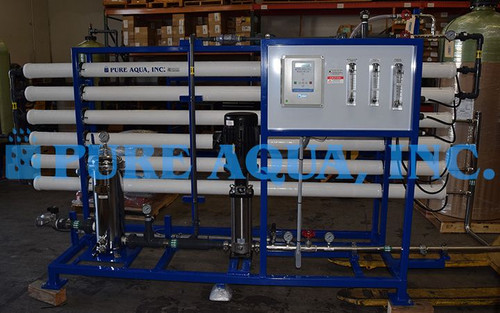Overview: This industrial reverse osmosis system was engineered to reduce hardness and silica from river water for a Palm Oil Manufacturing Facility in Guatemala.
Industry: Boiler Feed
- Powder coated carbon steel frame
- (8) FRP pressure vessels Codeline rated at 300 PSI
- (48) 8" TFC spiral wound sea water membranes (Hydranautics SWC5-LD)
- GF ORP sensor on feed line & GF conductivity sensor on product line
- Low- & high-pressure switches
- (2) Flow meters for reject and product line
- High pressure pump Grundfos CRN45
- 5-micron pre-filter with SS housing (SSC-66-316)
- PLC control panel (Siemens S7-1200).
- High pressure piping in SS 316 and low-pressure piping in SCH 80 PVC
[custom-specifications]
Water Concern: The water necessitated for the boiler feed process needs to at the very least, be rid of calcium and magnesium. These two elements are culprits to the hardness issue that arises when these elements are elevated. Likewise, hardness is generally a major contributor to scaling efforts and clogging potential of any metal surface. Purified water is necessary to facilitate a seamless operation while preventing additional labor costs and saving energy/fuel from overworking the system.
[/custom-specifications]
[custom-features]
Applied Solution: The recommended system for palm oil manufacturing was the industrial reverse osmosis system. This system includes a six-stage process to facilitate a seamless production of pure water. Beginning with a prechlorination system, the iron and manganese present in the water is oxidized. Then, a feed pump pressurizes the water into a triplex multimedia filter to reduce suspended solids and turbidity. This particular project consisted of three tanks; two of which operated primarily and a third on standby to be used during backwash cycles to prevent interruptions in production. Thirdly, a duplex green sand filter was included to reduce iron and manganese accounts. Next, a de-chlorination system is in place to reduce the levels of chlorine prior to contact with the RO membranes. Before the RO system, is an antiscalant dosing system to ensure the seamless production of purification and prevent scaling or fouling from occurring. Lastly, the water passes through the industrial RO system and produces perfectly pure water.
[/custom-features]
[custom-usage]
Low operating cost, compact size, reduced footprint, and high quality production of freshwater.
[/custom-usage]
Industrial Reverse Osmosis System for Boiler Feed 40 m3/hr - Guatemala - Data Sheet
 ENGLISH
ENGLISH ESPAÑOL
ESPAÑOL العربية
العربية PORTUGUÉS
PORTUGUÉS FRANÇAIS
FRANÇAIS

















